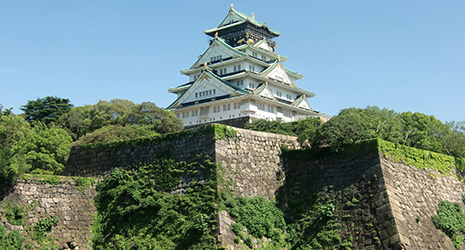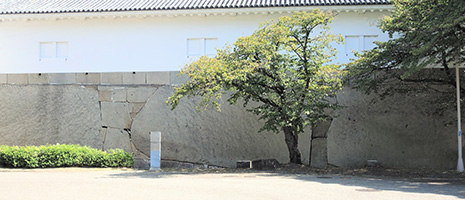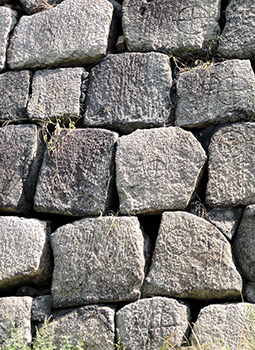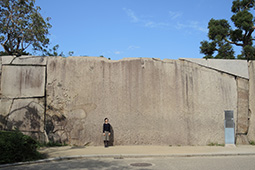INDEX
- English
- 日本語

Osaka Castle viewed over high stone walls - English
- 日本語

The three giant stones (lower section) carved from a single boulder to form a vertical barrier

Stones inscribed with the crests of feudal lords 
Tako-ishi (octopus stone), the biggest single castle stone in Japan 
One of the castle’s original stone walls, discovered during a 1984 excavation (February, 2021 photo)
October 2021
The Stone Walls of Osaka Castle

The ishigaki stone walls of Osaka Castle are clear evidence of the high standard of Japanese construction technology when the castle was built early in the seventeenth century.

Osaka is one of Japan’s leading major cities and will host the World Expo in 2025. At its center stands Osaka Castle, which is characterized not only by the impressive castle structure itself but also by the magnificent, 12-km-long stone walls that surround it.
Toyotomi Hideyoshi (1537–1598), a warlord who successfully unified Japan, commenced construction of Osaka Castle in 1583 and is said to have completed the central core of the castle, the Honmaru, in a year and a half. However, after Hideyoshi’s death, the castle was attacked and occupied by Tokugawa Ieyasu (1543–1616), the founder of the new (Tokugawa) shogunate. The present day castle is that reconstructed by the Tokugawa shogunate in the first half of the seventeenth century.
At the time of this reconstruction, Japanese castle-building technology had entered a period of maturity, so the stone walls of Osaka Castle were built using the best of technologies. We can observe a high degree of technical perfection, for example in the near complete absence of gaps between the stones in the walls.
By order of the shogunate, the tasks for constructing the stone walls were shared among the sixty-four daimyo (feudal lords) across western Japan. As evidence of this, stones inscribed with the various daimyo’s crests can be seen in the walls even now. In all, about one million granite stones are used in the walls. These were transported from nearby Mount Rokko and islands in the Seto Inland Sea, and from quarries on the island of Kyushu, some 420 km from Osaka.

It is thought that the large size of the castle walls, as well as their refined and orderly beauty, are a result of the daimyo staking their prestige on the quality of their workmanship.
Just beyond the main entrance that is the Otemon gate are three eye-catching giant stones, each around 5 meters high and between 8 to 11 meters wide. These stones were processed into the shape of sheet-like slabs to serve as vertical barriers at the foot of the stone walls.
“These three rocks are three slices of a single giant boulder,” says Atobe Makoto, chief curator at the Osaka Castle Museum. “This is amazing technology.”
Facing the entrance within the central core of the castle is another giant stone, the tako-ishi (octopus stone), the biggest single castle stone in Japan. It is 5.5 meters high, 11.7 meters wide and weighs about 108 tons. The stone is said to take its name from the fact that when the surface became wet the outline of an octopus appeared, though according to Atobe this phenomenon is no longer seen.

The stone wall on the east side of the central core is 34 meters high measuring from the base stones buried at the bottom of the moat, making it the highest among all Japanese castle walls. Atobe explains, “The wall is 24 to 25 meters high from the moat water surface to the top. If you view it from the opposite side of the moat, its height is quite wonderful to see.”
An old stone wall was discovered during an excavation in 1959, so we know that the current castle was built on the footprint of the first castle constructed by Toyotomi Hideyoshi. In a 1984 reinvestigation, another stone wall from when the castle was first built was excavated in good condition. At present, the “Toyotomi Hideyoshi Stone Wall Exhibition Project” is under way to build a facility to show this stone wall to the public.
You could say that Osaka Castle is continuing to tell us about the high standard of stone construction technology in Japan several hundred years ago.


